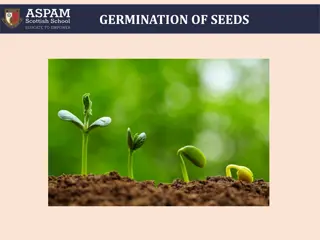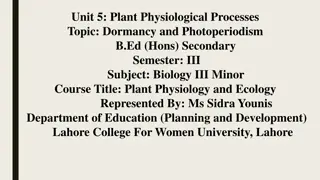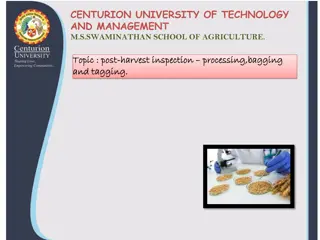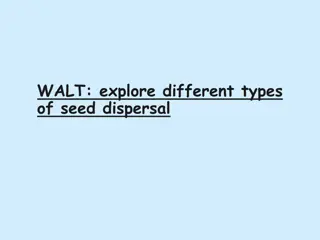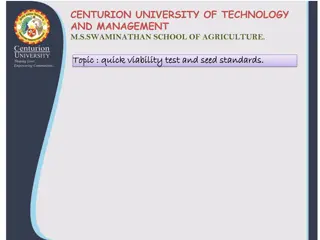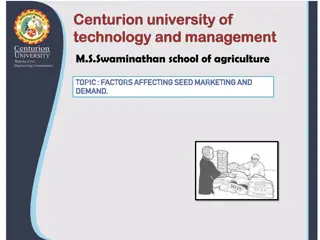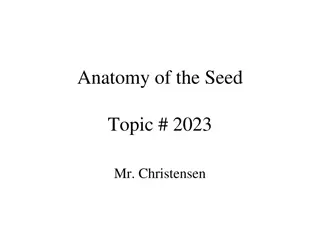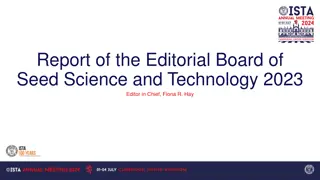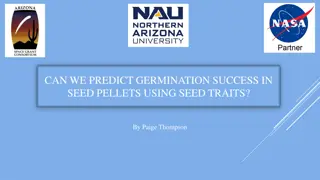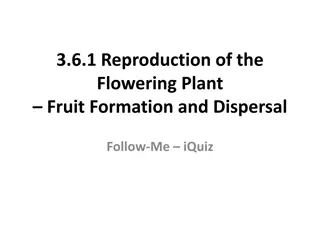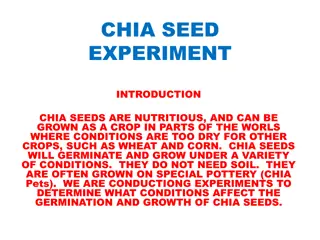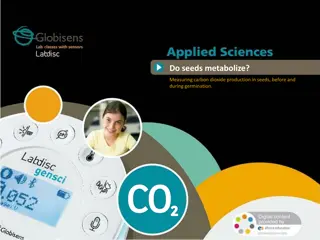Understanding Seed Metabolism: Measuring Carbon Dioxide Production Before and During Germination
Exploring the metabolic processes in seeds, this study aims to compare carbon dioxide production before and during germination. Students will hypothesize and verify using a carbon dioxide SensorLab sensor. Theoretical aspects of plant metabolism, including photosynthesis and cellular respiration, will be examined to understand energy production in plants. Through this investigation, insights into the common features of metabolism in plants and animals will be gained.
Download Presentation

Please find below an Image/Link to download the presentation.
The content on the website is provided AS IS for your information and personal use only. It may not be sold, licensed, or shared on other websites without obtaining consent from the author. Download presentation by click this link. If you encounter any issues during the download, it is possible that the publisher has removed the file from their server.
E N D
Presentation Transcript
Do seeds metabolize? Measuring carbon dioxide production in seeds, before and during germination.
Do seeds metabolize? Measuring carbon dioxide production in seeds, before and during germination Objective The objective of the study is for students to compare the amount of carbon dioxide generated before and during seed germination, through the formulation of hypothesis and subsequent verification using the carbon dioxide SensorLab sensor.
Do seeds metabolize? Measuring carbon dioxide production in seeds, before and during germination Introduction and theory Introduction Have you ever questioned what processes animals and plants have in common? We know that plants, animals and other creatures are living beings, because they share certain common features, including metabolism, which is needed for energy production. However, as in the case of human beings and other animals, metabolism in plants is not constant, but the processes are activated and change as they develop. What metabolicprocesses are carried out in both plants and animals?
Do seeds metabolize? Measuring carbon dioxide production in seeds, before and during germination Introduction and theory What metabolic processes do plants perform for energy? How do the above processes vary when a plant grows from a seed?
Do seeds metabolize? Measuring carbon dioxide production in seeds, before and during germination Introduction and theory Theoretical There are several processes associated with the metabolism of plants, many of which are variable, and increase or decrease depending on the stage of development in which the organism is found. Photosynthesis is an example of a metabolic process that is performed by plants where carbohydrates are produced from carbon dioxide, water and light energy according to the following chemical equation: 6CO2 + 6H2O 6O2 + C6H12O6 The equation indicates that for photosynthesis, six molecules of carbon dioxide (CO2) and six water molecules (H2O) are used to produce six molecules of oxygen (O2) and one carbohydrate molecule (C6H12O6). Oxygen molecules are released into the atmosphere, while the carbohydrate molecule is used for energy or stored.
Do seeds metabolize? Measuring carbon dioxide production in seeds, before and during germination Introduction and theory Another metabolic processes performed by plants throughout their lives is cellular respiration, which is performed in the mitochondria of plant cells to produce energy. During cellular respiration, organisms use organic compounds to produce ATP molecules, which are highly energetic and are transformed when the plant needs to use the energy stored in them. Carbon Dioxide Luminic Energy Oxygen Cellular respiration Photosynthesis
Do seeds metabolize? Measuring carbon dioxide production in seeds, before and during germination Introduction and theory The overall chemical equation for cellular respiration is: C6H12O6 + 6O2 6H2O + 6CO2 + 38ATP According to the equation above, during cell respiration the organisms use one carbohydrate molecule (C6H12O6) (which in the case of plants may have been produced during photosynthesis) and six oxygen molecules (6O2) to produce six water molecules (6H2O), 38 adenosine triphosphate molecules (38ATP) and six carbon dioxide molecules (6CO2). The carbon dioxide produced during cellular respiration is released by plants into the atmosphere.
Do seeds metabolize? Measuring carbon dioxide production in seeds, before and during germination Introduction and theory Now students are encouraged to raise a hypothesis which must be tested with an experiment. If the amount of CO2 produced or absorbed by a seed in a status of dormancy and germination was compared, what differences or similarities do you expect to find between them?
Do seeds metabolize? Measuring carbon dioxide production in seeds, before and during germination Activity description Students will measure the concentration of CO2 in a bowl where seeds are in a state of dormancy and then a state of seed germination using the SensorLab carbon dioxide sensor.
Do seeds metabolize? Measuring carbon dioxide production in seeds, before and during germination Resources and materials A plastic container with a lid USB cable Carbon dioxide sensor 30 germinated bean seeds 30 non-germinated bean seeds Duct tape
Do seeds metabolize? Measuring carbon dioxide production in seeds, before and during germination Using the SensorLab Using the sensor To perform measurements with the carbon dioxide sensor follow these steps: Open the GlobiLab software, connect the SensorLab and turn it on. Connect the carbon dioxide sensor to the SensorLab universal output. If this is the first time you are using the CO probe, connect the SensorLab to its AC/DC adapter and let the probe warm-up over a 24-hour period in order to reach optimal accuracy.
Do seeds metabolize? Measuring carbon dioxide production in seeds, before and during germination Using the SensorLab Click to setup the SensorLab. Configure the sensor to measure carbon dioxide at a rate of one sample per minute and with a total of 100 samples.
Do seeds metabolize? Measuring carbon dioxide production in seeds, before and during germination Using the SensorLab Once you have completed the sensor setup, start measuring by pressing the start button . Once you have completed the measurements, stop by pressing the stop button .
Do seeds metabolize? Measuring carbon dioxide production in seeds, before and during germination Experiment Fix the carbon dioxide sensor into the container using the duct tape. Place 30 non-germinated bean seeds into the container and close it using the cover. Seal the edges of the container using tape. Wait for the sensor to record ten samples of carbon dioxide inside the container, and once the time has elapsed, stop the measurements. Take out all the seeds from inside the container and ventilate it. Then place the 30 germinated seeds in the container and close it up again, sealing with duct tape while ensuring that the carbon dioxide sensor is inside.
Endothermic and exothermic reactions Do seeds metabolize? Performing different measurements to examine which reactions release or consume heat. and during germination Measuring carbon dioxide production in seeds, before Experiment Experiment Again wait until the sensor registers 10 samples of carbon dioxide inside the container and then stop the measurements.
Do seeds metabolize? Measuring carbon dioxide production in seeds, before and during germination Results and analysis If considered necessary, put notes in both graphs, using the button to indicate at what moment in the experiment the data corresponds. Show the maximum and minimum recorded carbon dioxide in each of the graphic values. Calculate the change in carbon dioxide recorded in germinated seeds and in those seeds that hadn t started the germination process. After performing the steps above it is recommended to change the way you view the graphics into a "bar graph" using the button clearly the tendency in each case. to see more
Do seeds metabolize? Measuring carbon dioxide production in seeds, before and during germination Results and analysis Looking at the shapes of the curves in the two graphs, how did the concentration of carbon dioxide vary in both types of seed? In which case was the highest and the lowest value of carbon dioxide recorded? How do the tendencies in each case relateto your earlier hypothesis?
Do seeds metabolize? Measuring carbon dioxide production in seeds, before and during germination Results and analysis The graph below should be similar to the one the students came up with:
Do seeds metabolize? Measuring carbon dioxide production in seeds, before and during germination Results and analysis The graph below should be similar to the one the students came up with:
Do seeds metabolize? Measuring carbon dioxide production in seeds, before and during germination. Conclusions What energy needs do germinated seeds have compared to dormant seeds, that could be relatedto the obtaineddataresults? Students must identify that in order for seeds to germinate they must spend a lot of energy, since the plant growth process involves high energy costs. This is consistent with the results obtained, because in order to produce energy in the form of ATP, plants release carbon dioxide into the atmosphere. As the dormant seeds do not activate these processes, a significant change is observed in the concentration of CO2. What metabolic processes (those mentioned in the theory section) could be relatedto the results obtainedin the case of sprouts? Students, noting the increase in the concentration of CO2 measured in germinated seeds, must indicate that the metabolic process involved is cellular respiration, since this is the only one in which carbon dioxide is released into the environment (in the case of photosynthesis CO2 is incorporated into the plant).
Do seeds metabolize? Measuring carbon dioxide production in seeds, before and during germination Activities for further application In order to increase the concentration of carbon dioxide and naturally decrease the concentration of oxygen in a biological system, what would you recommend to be incorporated into the system? Recommend using only non-germinated seeds, only germinatedseeds or a mixture of both? Justify your answer. Students should point out that cellular respiration increases the concentration of CO2, and O2 concentration decreases in the environment, since both molecules are reactants and products in the chemical equation of the process, respectively. Therefore, it would be appropriate to only place sprouts into the system because according to the experiment, these are the only ones performing cellular respiration at a considerable level. If the carbon dioxide levels in plants are measured at different stages of its life cycle after germination, What would you expect to find according to what you have learnedabout cellular respiration? z Students should remember that the theoretical section mentioned that plants perform cellular respiration throughout their life; therefore, it would be expected to register an increase in the concentration of CO2 in these organisms.




